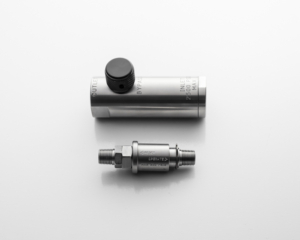2014 Golden Gas Award
We are honored to be a recipient of the 2014 Golden Gas Award from Gases & Instrumentation International Magazine in their Gas System Components category for our Excess Flow Prevention Valves. Check out this case study on the excess flow prevention valves written by Dave Kalen.
Excess Flow Prevention Valve (EFPV) Prevents Possible Explosion And Fire: Case Study
By Dave Kalen
Three different companies, S.I.S.U. Sales LLC., Pangaea Gases, and Premier Industries, pooled forces to develop the excess flow prevention valve (EFPV), a result of S.I.S.U. and Pangaea having studied the regulations to advise customers on compliance with applicable regulatory agency requirements. (See Figure 1) In this case, the applicable requirements are the DOT regulations that deal with operating portable emissions measurement system (PEMS) analyzers in a moving vehicle on the open road. These analyzers use flame ionization detection (FID) to identify various hydrocarbons in the vehicle’s exhaust, which requires the use of an open cylinder of flammable FID fuel while the vehicle is moving.* We discovered when investigating federal regulations, a requirement for complete shut-off of gas flow in the event of a leak between the regulator and the system. We worked with a large PEMS manufacturer to stimulate internal awareness that there was a requirement for flow shutoff in the event of a leak, which at that time the PEMS unit did not have. We further realized that few in the industry were even aware of this significant safety-related regulatory requirement.
Figure 2 shows a flammable gas cylinder in place inside the PEMS analyzer. There are a wealth of potential ignition sources in this environment which, in the event of a leak, could produce an explosion and fire. See the link below for the text of the DOT regulation requiring an EFPV.
Recently, an S.I.S.U./Pangaea customer, a large diesel engine OEM, was embarking on a test trip utilizing their PEMS unit while traveling on the road to measure emissions from their newly configured and calibrated engine. The cylinder of FID fuel composed of H2 and He was of necessity in the open position allowing the flow of flammable gas to the analyzer. The customer experienced a shut-off of the FID fuel and the PEMS unit indicated a fault. See Figure 3 for uniquely configured PEMS units. It has laboratory-grade non-dispersive infra-red (NDIR) for CO and CO2 detection, non-dispersive ultra-violet (NDUV) for NOx detection,(NO and NO2), an O2 sensor, and the FID for total hydrocarbons (THC).
Having just installed the new non-electric, totally mechanical, EFPV from S.I.S.U. Sales, it was at first thought this valve caused the shutdown.. The customer had a second EFPV and installed it on the regulator and experienced the same problem again. They immediately reported their suspicions to S.I.S.U. Working with the engineer, it was determined that the excess flow prevention valve was working precisely as designed. The excess flow prevention valves in this particular case were set to detect and shut off flow in excess of 0.5L/min. In the case of this PEMS unit, the normal consumption is approximately 0.218L/min. When the unit was lit and running, the operator put the EFPV in operational mode and the flow was shut off.
Normally, the operator would re-light the FID and be on his/her way. It was after several unsuccessful attempts that the technician did some further trouble-shooting of the PEMS unit. It was found to have a leak in the fuel line to the FID within the enclosure.
Without the excess flow prevention device, there wasn’t any way to sense that there was an excess flow of the FID fuel. The PEMS unit would not have known whether all of the flow was being consumed by the FID flame or was leaking. This excess flow was leaking directly into the PEMS enclosure. Had the PEMS unit been in the cab of the vehicle, as is the case in many applications, the driver and occupants in the test vehicle would have been at risk of an explosion and fire. This is a potentially serious safety issue especially applicable to those customers that employ multiple PEMS units. Such users include all major heavy-duty diesel OEMS, automobile manufacturers, and even the EPA. Because of the mechanical re-set feature built into the excess flow prevention valve, the operator was able to correct the problem and re-set the valve and continue with the required testing.
The EFPV is being developed for additional applications where there is a need to protect personnel from toxins and suffocation hazards. Liquids as well as gases are arrested in the event of excess flow. High pressure as well as ultra-low pressure ranges are being tested at this time.
DAVE KALEN is owner of S.I.S.U. Sales LLC. a manufacturer’s representative located in Jackson, Michigan. Dave worked with PAUL CLARK from AVL(currently Isuzu), JIM MACNEAL of Pangaea Gases and BLAKE JOHNSON from Premier Industries in the design and testing of the excess flow prevention valve.




